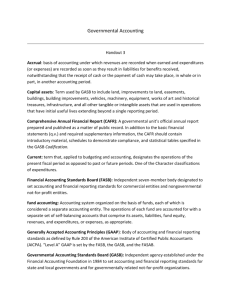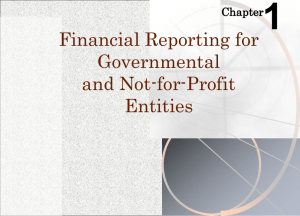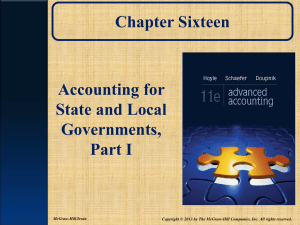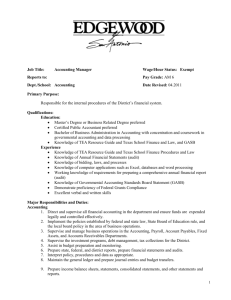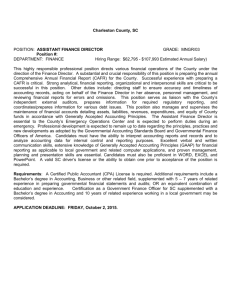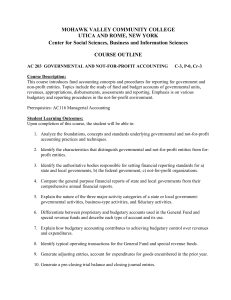Government and Not-for
advertisement
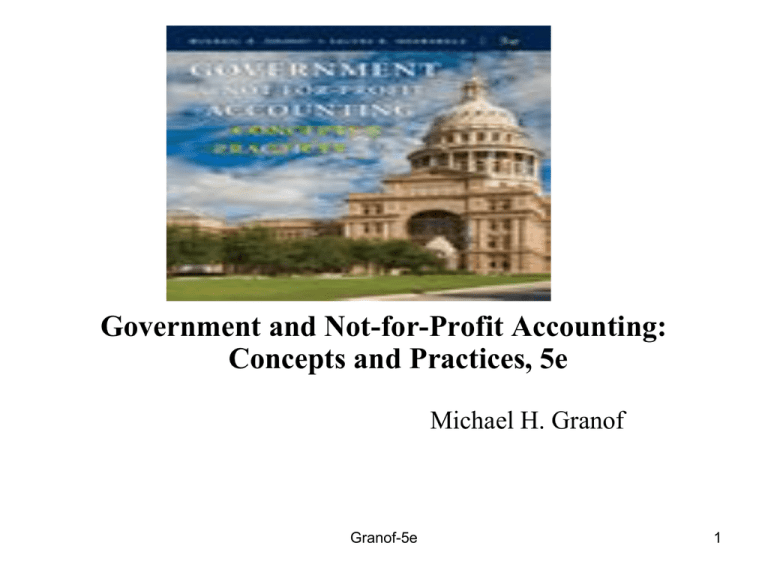
Government and Not-for-Profit Accounting: Concepts and Practices, 5e Michael H. Granof Granof-5e 1 Chapter 1 The Government and Not-for-Profit Environment Chapter 1 Granof-5e 2 Learning Objectives After studying Chapter 1, you should be able to: Understand the characteristics that distinguish governments and not-for-profit organizations from businesses (for-profit entities). Identify the features that distinguish governments from not-for-profits Identify authoritative bodies responsible for setting GAAP and financial reporting standards for different governmental and not-for-profit entities. Chapter 1 Granof-5e 3 Learning Objectives (cont’d) Compare the objectives of financial reporting for (1) state and local governments (2) the federal government and (3) not-for-profit organizations. Distinguish Management Discussion & Analysis (MD&A), basic financial statements, and Required Supplementary Information (RSI) of state and local governments in their comprehensive annual financial reports (CAFR). Chapter 1 Granof-5e 4 How Do Governmental and Not-ForProfit Organizations differ from Business Organizations? Chapter 1 Granof-5e 5 Budgets, not the market place govern. • through the budgetary process GNPs control or strongly influence both their revenue and expenditures. A government’s revenues may be determined by legislative fiat, so that the government may not be subject to the forces of competition faced by businesses. Expenditures may drive revenues. GNPs establish the level of services that they will provide, calculate their cost and then set tax rates and other fees to generate the revenues required to pay for them. Budgets drive accounting & financial reporting Constituents of an organization want information on the extent of adherence to the budget. They want assurance that the organization has not spent more than was authorized. They want to know that R & E estimates were reliable. So the accounting information must designed to provide that information. Need to ensure inter-period equity. - Interperiod equity is the concept that taxpayers of today pay for the ser vices that they receive and not shift the payment burd en to taxpayers of the future. So the accounting system of NGPs must provide information as to whether this objective is being attained. No direct link between revenues and expenses. GNPs revenues may not be related to expenditures. Donations to GNPs may increase from one year to the next without a corresponding increase in the quantity, quality, or cost of the services provided. Thus, the matching concept may have a different meaning for GNPs than for businesses. Businesses attempt to match the costs of specific goods or services with the revenues they generate. GNPs can associate only overall revenues with the expenditures they are intended to cover. In GNPs, revenues may not be linked to constituent demand or satisfaction. For businesses, the greater the revenues are, the greater the demand is—an indication that the entity is meeting a societal need. For GNPs, revenues may not be linked to constituent demand or satisfaction. An increase in tax revenues, for example, tells nothing about the quality of services provided. Therefore, a statement of revenues and expenditures cannot supply information about the demand for services. Different Role for Capital Assets Unlike businesses, GNPs make significant investments in assets that neither produce revenues nor reduce expenditures. Therefore, conventional business practices for valuing assets, such as comparing the present values of the asset’s expected cash outflows and inflows, may not apply to GNPs. Resources of government may be restricted. In contrast to business resources, many GNPs assets are restricted for particular activities or purposes. No distinguished ownership interests. GNPs typically cannot be sold or transferred, mainly absence of transferable ownership rights. If they are dissolved, there are no stockholders entitled to receive residual resources. Thus, their financial statements must be prepared for parties other than stockholders. Less distinction between internal and external accounting and reporting. • The line between external and internal accounting and reporting is less clear-cut for GNPs than for businesses. Ex: in business the budget is only an internal document. In GNPs, the budget is the key fiscal document and is as important to taxpayers, bondholders, and others as it is to managers. The budget is the most significant financial document, not the annual report. - For GNPS, budget takes center stage, because budget is the culmination of the political process. It encapsulate all the decisions made by an organization. - For business, the annual report is the most significant financial document, and the budget is not more than an internal document, seldom made available to investors or the general public. How Do Governmental and Not-For-Profit Organizations differ from Business Organizations? Power ultimately rests in the hands of the people People vote and delegate that power to public officials Created by and accountable to a higher level government – Power to tax citizens for revenue Chapter 1 Granof-5e 11 Governments Vs. Non-profits Governmental Accounting Standards Board(GASB): sets standards for all state and local governments and governmental non-profits. Established in 1984, it has 56 stds and 4 concepts stmts as of Dec. 2009. • Financial Accounting Standards Board (FASB): sets standards for non governmental non-profits except federal government. • Federal Accounting Standards Advisory Board (FASAB): sets standards for the federal government 12 Objectives of Financial Reporting—State and Local Governments (SLG) Financial reports are used primarily to: Compare actual results with the budget Assess financial condition and results of operations Assist in determining compliance Assist in evaluating efficiency Chapter 1 Granof-5e 13 OBJECTIVES OF FINANCIAL REPORTING AS SET FORTH BY THE GASB The overall objective of financial reporting is to meet the information needs of report users. Because of the unique characteristics of governments and their environment, the GASB has established accountability as the cornerstone of financial reporting. ‘‘Accountability,’’ it says, ‘‘requires governments to answer to the citizenry—to justify the raising of public resources and the purposes for which they are used.’’ Accountability ‘‘is based on the belief that the citizenry has a ‘right to know,’ a right to receive openly declared facts that may lead to public debate by the citizens and their elected representatives.’’ OBJECTIVES OF FINANCIAL REPORTING AS SET FORTH BY THE GASB The GASB has divided the objective of accountability into three sub-objectives: 1. Interperiod equity. ‘‘Financial reporting should provide information to determine whether current-year revenues were sufficient to pay for current-year services.’’ 2.Budgetary and fiscal compliance. ‘‘Financial reporting should demonstrate whether resources were obtained and used in accordance with the entity’s legally adopted budget. 3.Service efforts, costs, and accomplishments. ‘‘Financial reporting should provide information to assist users in assessing the service efforts, costs, and accomplishments of the governmental entity.’’ Objectives of Financial Reporting “ACCOUNTABILITY is the cornerstone of all financial reporting in government,” (GASB Concepts Statement No. 1, par. 56). What do we mean by accountability? How does “interperiod equity” relate to accountability? These questions are very important! Chapter 1 Granof-5e 16 Objectives of Financial Reporting (cont’d) What do we mean by accountability? Accountability arises from the citizens’ “right to know.” It imposes a duty on public officials to be accountable to citizens for raising public monies and how they are spent. Chapter 1 Granof-5e 17 Objectives of Financial Reporting: (cont’d) How does “interperiod equity” relate to accountability? Interperiod equity is a government’s obligation to disclose whether current-year revenues were sufficient to pay for current-year benefits—or did current citizens defer payments to future taxpayers? It is important to understand this concept of “interperiod equity”! Chapter 1 Granof-5e 18 GASB's Additional Objectives of Financial Reporting 1. Financial reporting should provide information about sources and uses of financial resources. It should account for all outflows by function and purpose, all inflows by source and type, and the extent to which inflows met outflows. 2. It should provide information about how the governmental entity financed its activities and met its cash requirements. 3. It should provide information necessary to determine whether the entity’s financial position improved or deteriorated as a result of the year’s operations. 4. Financial reporting should assist users in assessing the level of services that can be provided by the governmental entity and its ability to meet its obligations as they become due. GASB's Additional Objectives of Financial Reporting 5. It should provide information about the financial position and condition of a governmental entity. Financial reporting should provide information about resources and obligations, both actual and contingent, current and noncurrent. The financial reporting should provide information about tax sources, tax limitations, tax burdens, and debt limitations. 6. It should provide information about a governmental entity’s physical and other nonfinancial resources having useful lives that extend beyond the current year, including information that can be used to assess the service potential of those resources. 7. It should disclose legal or contractual restrictions on resources and risks of potential loss of resources. Objectives of Financial Reporting— Federal Government Accountability is also the foundation of Federal government financial reporting Federal Accounting Standards Advisory Board (FASAB)’s standards are targeted at both: --internal users (management), and --external users Chapter 1 Granof-5e 21 Users of financial reports • Governing boards: the prime recipients of the report because they approve budgets, major purchases, contracts and significant operating policies. • • • • • Investors & creditors Citizens & organizational members Donors & grantors Regulatory agencies Employees Importance of Accounting for SLGs • There are over 89,500 state and local governments in the United States • State and local governments are responsible for approximately 14 percent of total employment in the United States • State and local governments collected approximately $1.3 trillion in tax receipts in 2007. Chapter 1 Granof-5e 23 Composition of the Local U.S. Government Units (16,519) (19,492) (13,051) (3,033) (37,381) Chapter 1 Granof-5e 24 Importance of the NFP Sector Size and Scope 2006-2007: • Number of not-for-profit organizations 1.9 million • Total nonprofit sector revenues (2006) $1.1 trillion • Annual contributions from private sources (2007) $306.39 billion • Percentage of wages and salaries paid in the US by NFP 8.3% • Percentage of NI attributed to the Indep. sector (2006) 5.3% Giving 2007: • • • • Individuals contribution (74.8%) Charitable bequests (7.6%) Foundations (12.6%) Corporate (5.1%) Chapter 1 229.03 billion 23.15 billion 38.52 billion 15.69 billion Granof-5e 25 Importance of the NFP Sector Size and Scope 2006-2007: • Number of not-for-profit organizations 1.9 million • Total nonprofit sector revenues (2006) $1.1 trillion • Annual contributions from private sources (2007) $306.39 billion • Percentage of wages and salaries paid in the US by NFP 8.3% • Percentage of NI attributed to the Indep. sector (2006) 5.3% Giving 2007: • • • • Individuals contribution (74.8%) Charitable bequests (7.6%) Foundations (12.6%) Corporate (5.1%) Chapter 1 229.03 billion 23.15 billion 38.52 billion 15.69 billion Granof-5e 26 Sources of GAAP and Financial Reporting Standards FASB – Financial Accounting Standards Board Business organizations: ex. Wal-Mart Nongovernmental not-for-profits: ex. Rice University, American Cancer Society, GASB – Governmental Accounting Standards Board Governmental entities: ex. New York City, Atlanta Governmental not-for-profits: ex. University of Houston FASAB – Federal Accounting Standards Advisory Board Federal Government and its agencies Ex. Department of Agriculture, Department of Transportation, Department of Energy, Department of Education, Department of Defense, HUD, HHS and others. Chapter 1 Granof-5e 27 General Purpose External Financial Reports (SLGs) Source: GASB Statement 34 Management’s discussion and analysis Government-wide financial statements Fund financial statements Notes to the financial statements Required supplementary information (other than MD&A) Chapter 1 Granof-5e 28 Comprehensive Annual Financial Report (CAFR) CAFR -- recommended, but not mandatory Three Sections: 1. Introductory section 2. Financial section 3. Statistical section Chapter 1 Granof-5e 29 CAFR - Introductory Section Title page Contents page Letter of transmittal Other (as desired by management) You can view online the City of Houston’s Annual Reports for the years 2009, 2008, and other years at the following link: http://www.houstontx.gov/controller/cafr.html Chapter 1 Granof-5e 30 CAFR—Financial Section (GASB Statement No. 34) Auditor’s report MD&A Basic Financial Statements Required Supplementary Information RSI (Other than MD&A) Combining the individual fund statements and schedules Chapter 1 Granof-5e 31 Management’s Discussion and Analysis (MD&A) Brief objective narrative providing management’s analysis of the government’s financial performance This is basically “Tell it like it is.” Chapter 1 Granof-5e 32 Basic Financial Statements Government-wide Financial Statements Statement of Net Assets Statement of Activities Fund Financial Statements (see next slide) Notes to the Financial Statements The Government-wide Financial Statements are the TWO additional F/S required under GASB 34. Chapter 1 Granof-5e 33 Fund Financial Statements Governmental-type Funds Balance Sheet Statement of Revenues, Expenditures, and Changes in Fund Balances - Governmental Funds with reconciliation Proprietary-type Funds Statement of Net Assets Statement of Revenues, Expenses, and Changes in Fund Net Assets Statement of Cash Flows Fiduciary-type Funds Statement of Fiduciary Net Assets Statement of Changes in Fiduciary Net Assets Chapter 1 Granof-5e 34 CAFR - Statistical Section Tables and charts showing multiple-year trends in financial and socioeconomic information Chapter 1 Granof-5e 35 Fund Accounting Fund accounting reports financial information for separate self-balancing sets of accounts, segregated for separate purposes or to account for resources restricted as to use by donors or grantors Funds are separate accounting and fiscal entities Chapter 2 explains the concept of fund accounting. Chapter 1 Granof-5e 36
